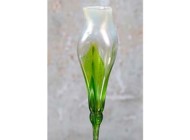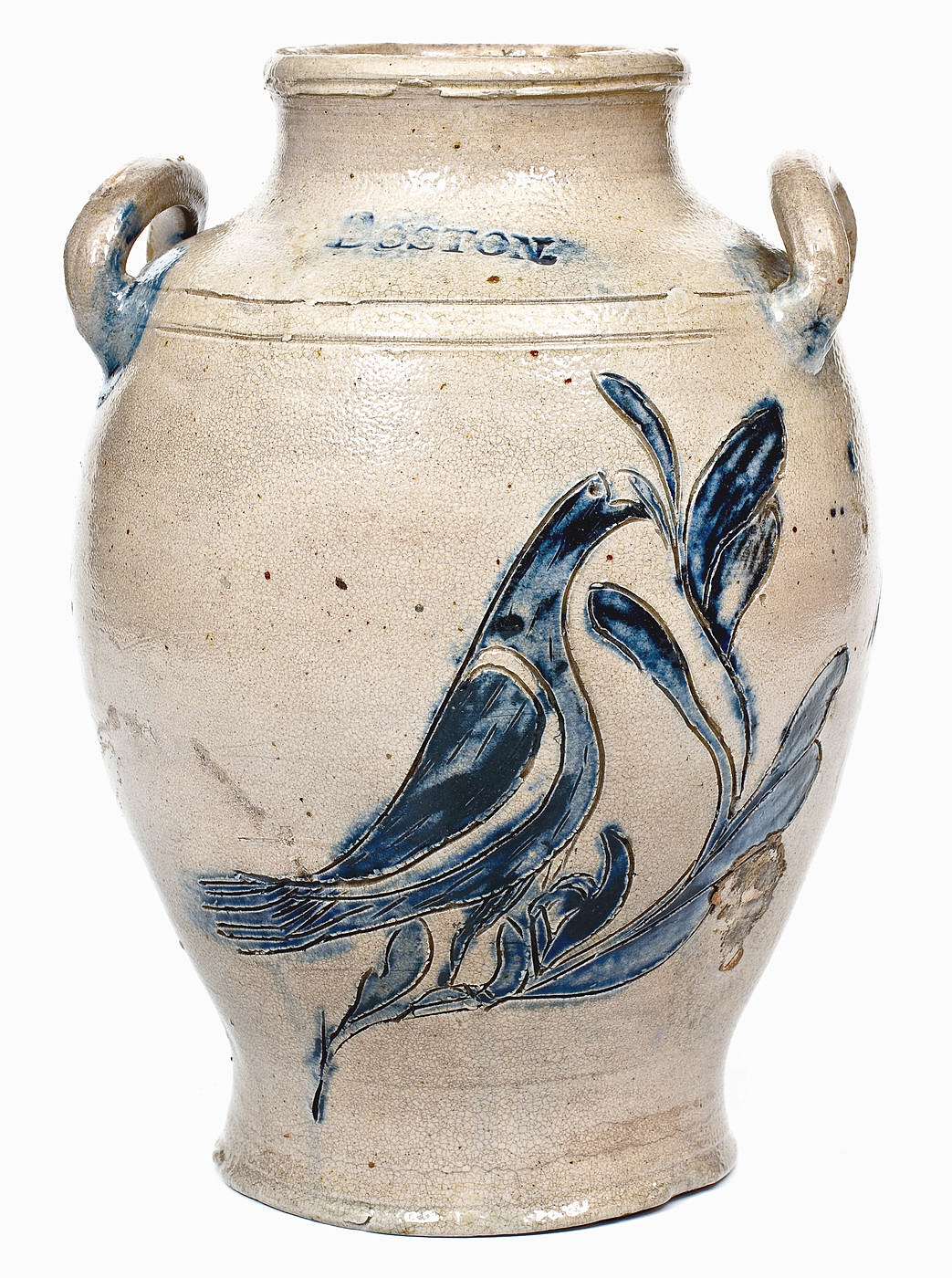
The sale’s top lot was a presentation jar inscribed to “Mrs Elesebeth Tarbell,” that sold for $180,000 to collector Adam Weitsman. Bill Samaha had purchased it out of descendents of the Tarbell/Hawkes family in the 1970s, when the family said it was made by Elizabeth Tarbell’s son, Nathaniel Tarbell. Elizabeth’s husband, Jonathan Tarbell, was first cousins with the potter William Tarbell, who had an earthenware shop in Beverly, Mass. Known for the stamp the firm used, this piece was made at the Frederick Carpeneter pottery in Charlestown.
Review by Greg Smith, Catalog Photos Courtesy of Crocker Farm Auctions
SPARKS, MD. – The final call came in at $1,497,990 for Crocker Farm’s spring sale, which ran in a timed online format on the firm’s website from March 26 to April 9. The 473 lots within found new homes for as little as $90 and as much as $180,000.
The sale’s top end broke an auction record for any piece of Massachusetts stoneware when the “Mrs Elesebeth Tarbell” jar brought $180,000 from collector Adam Weitsman. The 10-inch-high presentation jar was stamped “Boston” and featured an incised and cobalt-highlighted bird perched on a branch to one side and a flowering plant to the other. It was dated 1806 and made at the Frederick Carpenter pottery in Charlestown. Elizabeth Tarbell was the wife of Revolutionary War veteran Jonathan Tarbell, who was first cousins with William Tarbell, the Danvers-trained potter who established an earthenware shop in Beverly in 1782. In the 1970s, the jar had been bought by dealer Bill Samaha out of the Tarbell/Hawkes family, where it had descended since it was presented to Miss Tarbell. Samaha sold it to the consignor of the jar. The family related that lore said it had been made by Nathaniel Tarbell as a gift to his mother, though the alternate spelling of her name may suggest a different maker within the family, the auction house posited.
“The Boston stamp was used by Jonathan Fenton earlier and then Frederick Carpenter, their wares were made in an English style in very basic, iron dips,” auction principal Mark Zipp said. “The fact that this example was not only cobalt-decorated, but had incredible incised design that covered much of the surface, and that it had a presentation to its front, set it apart as one of the finest pieces of Boston stoneware known. The piece contrasts with a body of work that is sparsely decorated.”
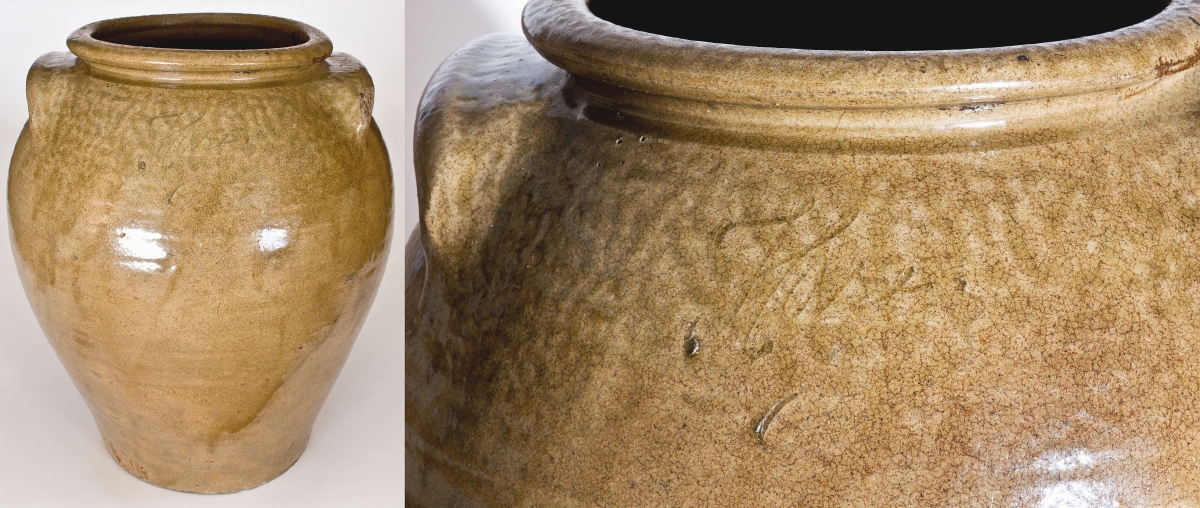
One of only two known signed works by Harry, an enslaved turner at the Pottersville Stoneware Manufactory and possible predecessor at that pottery to Dave, this 4-gallon stoneware jar went out at $120,000 to an art collector. The signed work and unique attributes, including the flattened handles, will allow the firm to attribute other works to the potter in the future.
Coming in at $120,000 from an art collector was a circa 1840 alkaline-glazed stoneware jar incised “Harry,” for the enslaved potter who worked at the Pottersville Stoneware Manufactory between 1839 and 1843. It is one of two known examples bearing Harry’s name, and the firm called it “Among the most important discoveries in Southern ceramic or African-American art to come to light in years.” The jar had been found in Columbia, S.C. Harry was a well-documented turner, the auction house said, referencing ledgers from the manufactory. “As the founding stoneware shop of the Edgefield pottery tradition and the one credited with introducing alkaline glaze to the United States, it is difficult to overstate its importance to the development of America’s ceramic craft as a whole. Pottersville is meanwhile the shop that began the career of Dave, whose name appears in an 1818 mortgage associated with the manufactory in a manner similar to the pictured documents referencing Harry. Harry first appears in a January 1839 indenture between well-known Edgefield potter Collin Rhodes and John H. Hughes, a man who took over Rhodes’ share of an interest in Pottersville.” The last mention of Harry came in an ad in the Edgefield Advertiser dated February 21, 1843, where Jasper Gibbs & Co announced the sale of “our entire Pottersville property…consisting of four Negroes, viz. three Turners and one Wagoner” along with a “stock of Stone Ware” and other property. Current scholarship suggests that Dave left Pottersville sometime between 1836 and 1840 for John Landrum’s Horse Creek Valley pottery.
Zipp said, “When you have one, it’s an anomaly, but when you know of two signed works, you take notice. Did he do it with frequency? Was he someone very much like Dave, who for whatever reason signed his work? All information kind of points to that. This was not just some one-off thing, it was something he did. It’s exciting to have another potter that signed his ware in Edgefield. The story about Dave was that he was unique in that regard, but now there are two. There’s no evidence they were at Pottersville together, but there’s a good chance they were. You can imagine that there’s a very good chance that these turners, which was the most skilled position in a pottery, that they could have sat side-by-side and seen each other doing that kind of thing. It’s intriguing to think about how they may have influenced each other’s works.
The signed work led the firm to attribute another in the sale to the hand of Harry. The 16-inch-high 6-gallon jar went out at $6,000. Crocker Farm wrote, “The jars feature a confidently-potted form with wide shoulder and mouth, narrow rim, punctates and an impressed C or horseshoe mark. Most distinctive about both jars is the handle construction; the handles are thicker, flatter and closer to the body of the jar than Dave’s handles, and include a rounded edge. It is these handles, we believe, that will serve as a clear diagnostic trait in determining future works by Harry.”
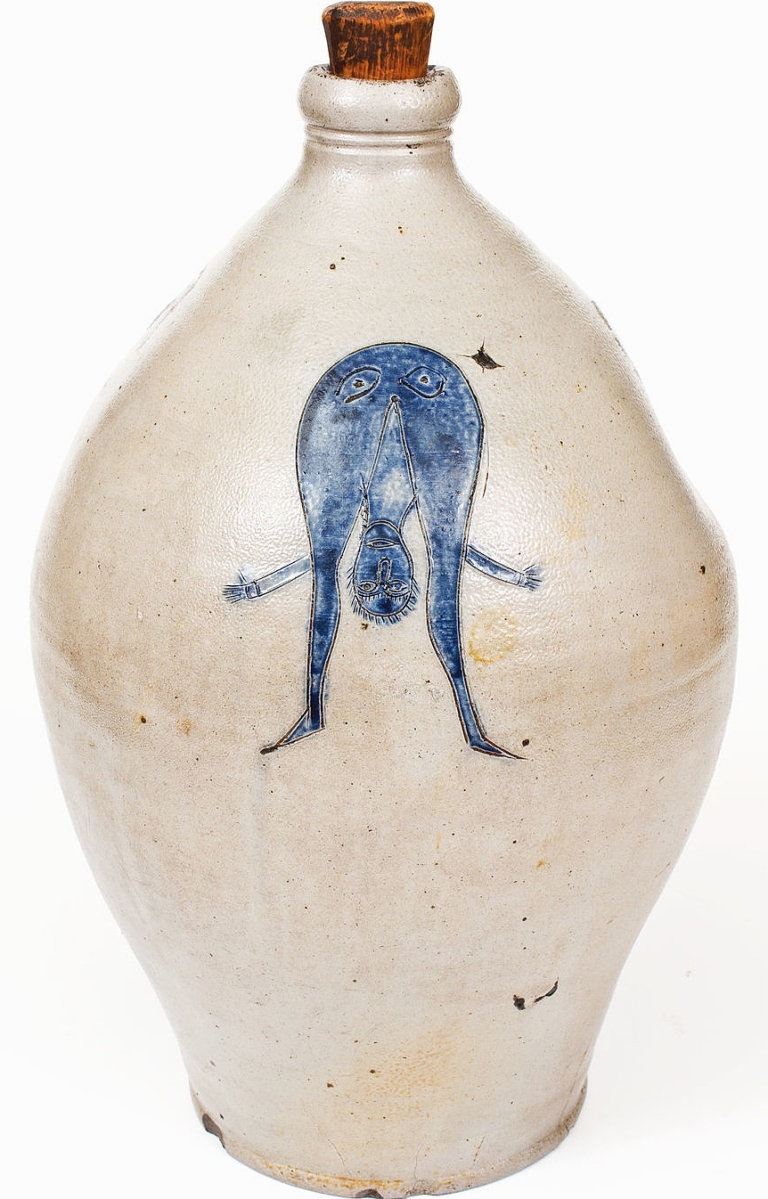
Included in the canon of exceptional American stoneware was this 3-gallon incised stoneware jug that brought $21,600 to collector Adam Weitsman. He said he remembered seeing it in Barry Cohen’s collection as a teenager and felt determined to own it here. A pair of eyes appear on the rear end of the figure bent over and looking through his legs, interpreted to be a pun on “hindsight” or “mooneyed,” a slang term for drunk. The jug was published and exhibited.
“The glaze was also very similar, if you put the two next to each other, there was no doubt they were thrown by the same hand, the only difference was that one wasn’t signed,” Zipp said. “It’s so very difficult to attribute these, it really only happens with Dave. But there’s a lot of enslaved potters who went completely unnoticed. This is kind of a smoking gun that will allow us to attribute his work in the future. There will be more that pop up.”
Dave Drake was not to be left behind by his possible predecessor as a 9-gallon stoneware jar dated August 5, 1851 sold for $66,000. The jar was made by Drake at Lewis Miles’ Stoney Bluff Manufactory. In 2006, scholars Goldberg and Witkowski said it was the only dated 1851 piece known by the potter. From about six years later was a left-leaning 3-gallon jug by Dave, who was still working at Lewis Miles’ Stoney Bluff Manufactory. It sold for $15,600.
Other Edgefield works found favor, including a 5-gallon double-handled stoneware jug from the Collin Rhodes Pottery, circa 1850. The work featured kaolin slip-trailed foliate with a looping stem at the center, the reverse decorated with a flowering plant and a central blossom, the words “C Rhodes / Maker” appearing under the spout. The jug brought $30,000 as the auction house said it was among the finest examples from that pottery they had ever offered.
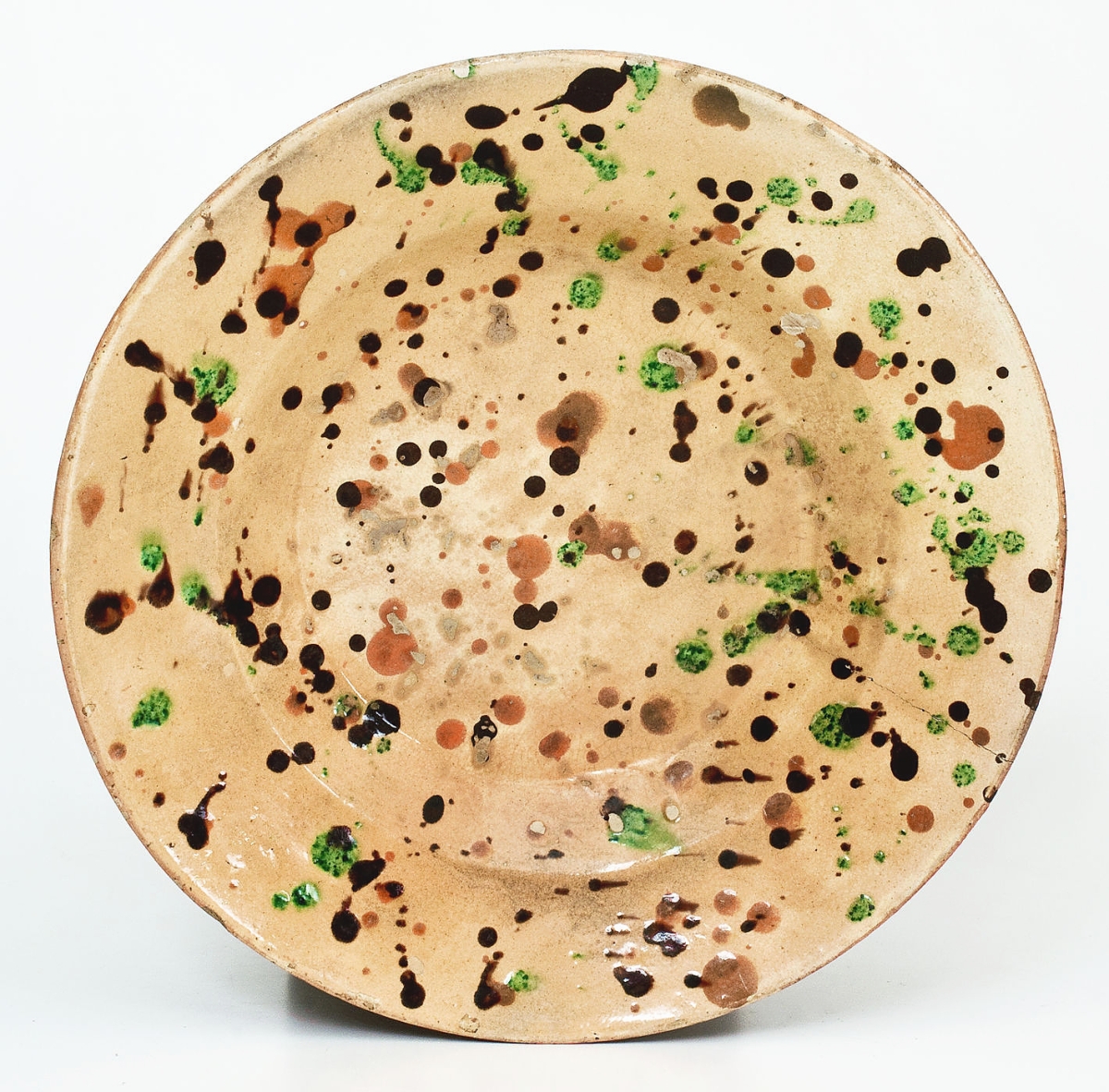
A remarkable spatter-decorated redware dish attributed to Solomon Loy of Alamance County, N.C., went out at $34,800. Cream slip under manganese, copper and orange slip spatters. 11¼ inches diameter.
Southern pottery continued on with two Twentieth Century face jugs. Of Alabama origin was a rare full-bodied example featuring the figure’s head coming out of a jacket-wearing torso. In a salt-over-Albany-slip glaze, it recently surfaced in the Northwestern United States and the firm called it “Among the most outstanding examples of Alabama stoneware ever to come to auction.” The 12½-inch-high jug went out at $33,600. Zipp said the torso face jugs and the glaze are indicative of an Alabama origin. The use of shards of broken china for the teeth was a tradition that swept through the Southern potters in Alabama, Georgia and North Carolina in the Twentieth Century. Among the top results for any Meaders family pottery was an alkaline-glazed stoneware face jug by Cheever Meaders, the son of Meaders Pottery founder John Milton Meaders. The firm related that few face jugs by Cheever are known, more prolific in the form were his sons, Lanier, John, Edwin and Reggie. The jug went out at $19,200.
Of Ohio origin and circa 1876 was a crock featuring an attractive freehand inscription, “American StoneWare,” that sold for $12,000. The firm said it was likely made for display at a fair or exhibition, probably during the centennial. It had provenance to the Al Behr and John Martinelli collections.
“It almost doubled as a trade sign, a large-size crock with the writing on it,” Zipp said. “To have that inscription is particularly rare. The ‘American’ emphasized a pride of American-made products, a nationalism.”
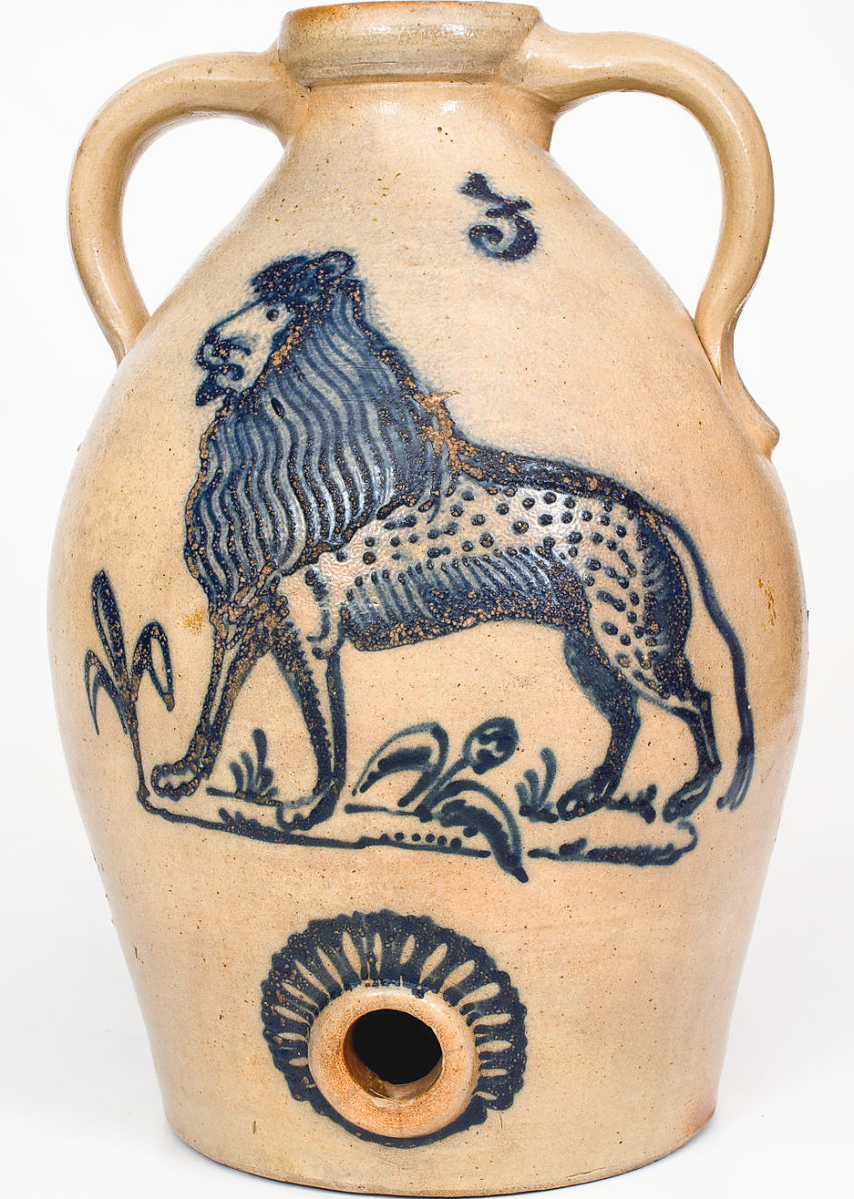
A 3-gallon stoneware cooler with a slip-trailed lion decoration by either Burger or Stetzenmeyer of Rochester, N.Y., went on to bring $32,400. The firm said it was unusual that it did not have a signature, indicating it may have been made for someone within the potting community. 16 inches high.
If you ever wondered how big a 50-gallon cooler would be, it measures 40¾ inches high – Zipp said it was the largest piece of salt-glazed, cobalt decorated stoneware in existence. George Washington’s face was brushed onto the cooler that went out at $31,200 to a collector. The firm said it was likely made to commemorate an anniversary or centennial. It had been purchased by the consignors in 1978 from a home in Missouri, which had acquired it in 1928 from that family’s uncle. When the consignors went to pick it up from the seller, it was stored outside under a bush. The cooler was signed “AFG.”
Good humor was noted in a 3-gallon stoneware jug incised with a man bent over, looking between his legs with eyes appearing on the man’s rear end. The wordplay is interpreted to be a pun on “hindsight” or “mooneyed,” a slang term for drunk. It is attributed to the Albany, N.Y., William Capron Pottery and brought $21,600 from collector Adam Weitsman, who said it held a place of nostalgia for him as he remembered seeing it in Barry Cohen’s collection as a teenager. Dated 1800-05, Crocker Farm said it was one of the earliest renderings of a human form in American stoneware. The jug has a prominent place in the canon of great examples, having held court in the Cohen collection, exhibited in 1975 at the Abby Aldrich Rockefeller Folk Art Museum in Williamsburg, Va., and illustrated in Sumpter Priddy’s American Fancy: Exuberance in the Arts 1790-1840. It had been handled at different points by David Schorsch, America Hurrah Antiques and Allan Katz.
Redware was led by a bowl attributed to Alamance County potter Solomon Loy, circa 1825-40. The 11¼-inch diameter example featured a cream-colored slip with spattered manganese, copper and orange slips. From Norwalk, Conn., came a “John Adams” slip-decorated redware loaf dish, attributed to Absalom Day or Asa E. Smith, that went out at $18,000. The firm noted that the use of a copper slip is associated with early pieces made by Day in the late Eighteenth or early Nineteenth Century.
The firm’s July sale will feature an Anna Pottery match tower sculpture that speaks to the Colfax Massacre and American Reconstruction.
All prices reported include buyer’s premium. For information, www.crockerfarm.com or 410-472-2016.





























